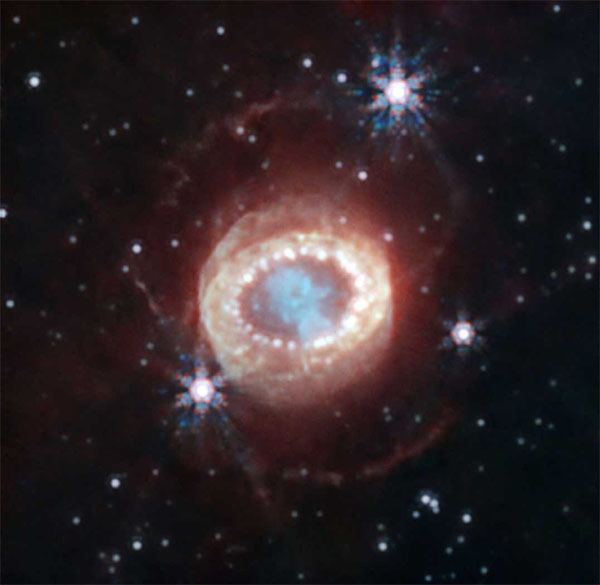| Mar 13, 2024 |
|
|
|
(Nanowerk News) Physicists often turn to the Rayleigh-Taylor instability to explain why fluid structures form in plasmas, but that may not be the full story when it comes to the ring of hydrogen clumps around supernova 1987A, research from the University of Michigan suggests.
|
|
In a study published in Physical Review Letters (“Hydrodynamic mechanism for clumping along the equatorial rings of SN1987A and other stars”), the team argues that the Crow instability does a better job of explaining the “string of pearls” encircling the remnant of the star, shedding light on a longstanding astrophysical mystery.
|
 |
| The simulation shows the shape of the gas cloud on the left and the vortices, or regions of rapidly rotating flow, on the right. Each ring represents a later time in the evolution of the cloud. It shows how a gas cloud that starts as an even ring with no rotation becomes a lumpy ring as the vortices develop. Eventually the gas breaks up into distinct clumps. (Image: Michael Wadas, Scientific Computing and Flow Laboratory)
|
|
“The fascinating part about this is that the same mechanism that breaks up airplane wakes could be in play here,” said Michael Wadas, corresponding author of the study and a graduate student in mechanical engineering at the time of the work.
|
|
In jet contrails, the Crow instability creates breaks in the smooth line of clouds because of the spiraling airflow coming off the end of each wing, known as wingtip vortices. These vortices flow into one another, creating gaps—something we can see because of the water vapor in the exhaust. And the Crow instability can do something that Rayleigh-Taylor could not: predict the number of clumps seen around the remnant.
|
“The Rayleigh-Taylor instability could tell you that there might be clumps, but it would be very difficult to pull a number out of it,” said Wadas, who is now a postdoctoral scholar at the California Institute of Technology.
On a black backdrop, dim or distant stars glow white, with three nearer or brighter stars producing hexagonal diffraction patterns like rainbow snowflakes. In the middle of the frame, the supernova remnant resembles a reptilian eye, with a teal cloud in the center ringed by bright white dots that are the clumps of hydrogen lit up by the shockwave from the supernova. A pale haze surrounds the ring of dots, with other less distinct dots inside.
|
|
Supernova 1987A is among the most famous stellar explosions because it’s relatively close to Earth at 163,000 light years away, and its light reached Earth at a time when sophisticated observatories existed to witness its evolution. It is the first supernova visible to the naked eye since Kepler’s supernova in 1604, making it an incredibly rare astrophysical event that has played an outsized role in shaping our understanding of stellar evolution.
|
 |
| A near-infrared image of the remnant left behind by supernova 1987A, taken by the James Webb Space Telescope. The hydrogen clumps known as the “string of pearls” appear as a ring of white dots around the teal center of the stellar remnant, still shining brightly due to the energy imparted by the supernova shockwave. The number of clumps is consistent with the Crow instability having caused them to form. (Image: NASA, ESA, CSA, M. Matsuura (Cardiff University), R. Arendt (NASA’s Goddard Spaceflight Center & University of Maryland, Baltimore County), C. Fransson (Stockholm University), J. Larsson (KTH Royal Institute of Technology), A. Pagan (STScI))
|
|
While much is still unknown about the star that exploded, it is believed that the ring of gas surrounding the star ahead of the explosion came from the merger of two stars. Those stars shed hydrogen into the space around them as they became a blue giant tens of thousands of years before the supernova. That ring-shaped cloud of gas was then buffeted by the stream of high-speed charged particles coming off the blue giant, known as a stellar wind. The clumps are believed to have formed before the star exploded.
|
|
The researchers simulated the way the wind pushed the cloud outward while also dragging on the surface, with the top and bottom of the cloud being pushed out faster than the middle. This caused the cloud to curl in on itself, which triggered the Crow instability and caused it to break apart into fairly even clumps that became the string of pearls. The prediction of 32 is very close to the observed 30 to 40 clumps around the supernova 1987A remnant.
|
|
“That’s a big piece of why we think this is the Crow instability,” said Eric Johnsen, U-M professor of mechanical engineering and senior author of the study.
|
|
The team saw hints that the Crow instability might predict the formation of more beaded rings around the star, further out from the ring that appears brightest in telescope images. They were pleased to see that more clumps seem to appear in the shot from the James Webb Space Telescope’s near-infrared camera, released in August last year, Wadas explained.
|
|
The team also suggested that the Crow instability might be at play when the dust around a star settles into planets, although further research is needed to explore this possibility.
|
- SEO Powered Content & PR Distribution. Get Amplified Today.
- PlatoData.Network Vertical Generative Ai. Empower Yourself. Access Here.
- PlatoAiStream. Web3 Intelligence. Knowledge Amplified. Access Here.
- PlatoESG. Carbon, CleanTech, Energy, Environment, Solar, Waste Management. Access Here.
- PlatoHealth. Biotech and Clinical Trials Intelligence. Access Here.
- Source: https://www.nanowerk.com/news2/space/newsid=64846.php





